Public Approach Front
original east front
Roma
Problems? This is the least intact of the 4 mythological reliefs. The 2 surviving remnants show only a profile view of a draped thigh and lap of a seated figure facing left, and a shield with various details. The 2 fragments are thought to have been originally joined. Through analogy with other known images, these two remnants strongly suggest the seated figure of the goddess Roma, with a pile of weapons. This imagery would be ideally suited for this monument and the identification has been accepted by nearly all scholars. There has also been little disagreement with the more recent suggestion that 2 young gods stood at either side of the seated Roma; Virtus (Virtue) at the left and Honos (Honor) at the right. Although not indicated in the incised 1938 reconstruction drawing, these 2 figures have been added in the current proposed color reconstruction.
I find the 1938 reconstructions of this panel in some ways inconsistent with the character of the Ara Pacis.
The design of the entire monument is pervasively balanced, left to right and front to back. Moretti's 1938 placement of Roma must surely be too far to the left. It seems highly unlikely that more of the imagery would have been behind the goddess, as in Moretti's reconstruction. Roma’s head would in all likelihood have been slightly to the right of center, her head and figure balancing those of Tellus on the opposite panel.
As far as I can tell, the only basis for the 1938 placement of Roma is the very small detail of leaves on the back of the fragment of the shield in the Roma relief, thus belonging to the festoon relief on the interior of the precinct wall (see p.157 and figs.126 and 127 in Moretti, 1948; or see figs. 8 amd 9 on plate 6 in Studniczka, 1909, illustrated on the website). These leaves are very small and seem only tentatively connected to the any specific detail of the swag. Given the many misaligned fragments in the 1938 reconstruction, forced by the extreme time pressure, the placement of these leaves seems highly tentative. They point down and could equally well have been on the left side of the largely missing swag. Without a secure location of these leaves on the inside wall, I do not find the placement of the shield and Roma in the 1938 restoration convincing.
In addition, we should note that the lack of any indication of background or additional foreground imagery in the 1938 reconstruction, although no doubt justified, leaves this east front unbalanced and is inconsistent with the overall design of the monument. The 2 relief panels on the ceremonial entrance front (original west front) are carefully balanced; the 2 panels equal in weight and both covered with imagery. Although the incised and drawn lines added to the Lupercal panel are necessarily hypothetical, they are clearly distinguished from the original marble so as not to mislead and serve to provide the otherwise missing balance to the facade. Without more remnants for the Roma panel or related images of the entire scene, suggestions for what imagery covered the rest of this panel must of course be hypothetical. But without any suggestion of the overall scene, the public approach front is unbalanced, unlike any of the other exterior or interior facades of the surrounding precinct wall.
Originally painted? As with so many ancient monuments, the original surface of the Ara Pacis was not lightly toned marble but instead brightly colored paint.
Without this essential aspect of the imagery, interpretations of meaning are necessarily incomplete and in part speculative. In recent years, increasing attempts have been made to suggest the original appearance of various ancient monuments, not only of Greece and Rome but also of India, China, and Pre-Columbian America. The recently proposed reconstructions of the Ara Pacis colors are now impressively demonstrated with color projection directly on the front facades. Based largely on parallels with Roman wall paintings of the time, they are especially to be applauded because they suggest the partly naturalistic appearance of the originals, instead of the flat, cartoon-like treatment of many color reconstructions.
TO ZOOM IN ON THE LARGE IMAGES, USE THE BUTTONS AT TOP-LEFT.
Tips for using this website
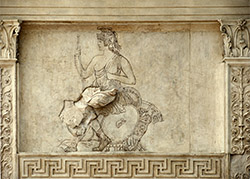
Only 2 original fragments of this relief have survived, but through analogy with other known images they suggest the figure of the goddess Roma, sitting on a pile of trophy weapons. photo July 2008
|
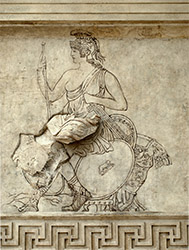
Roma. The incised drawing added to suggest the full figure and armor is partly hypothetical but based on related images of Roma on contemporary Roman coins and reliefs. photo July-Oct. 2008 |

Demonstration of an innovative, technically complex color projection to suggest the original colors of the front facades. In this case the projection also suggests two missing figures. photo May 2010
|
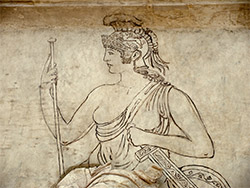
Roma, the upper portion hypothetically reconstructed with lines incised and drawn in mortar. photo July 2008
|
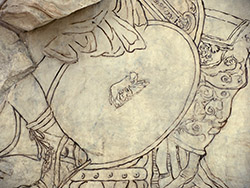
Lower-right area of panel, hypothetically reconstructed with an image of Romulus, Remus being suckled by the she-wolf on a shield. photo July 2008
|
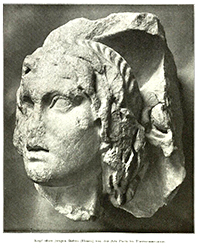
The history of this important head is reviewed on this web site under "fragments". Scanned from Franz Studniczka, "Zur Ara Pacis", Abb, Sächs. Ges. der Wissenschaften, XXVI, 1909, pl.7. Reproducd with appreciation. |
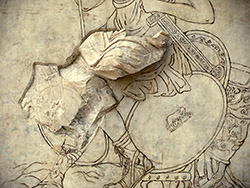
Only these 2 original fragments, rediscoverd in 1903, are known to have survived. The upper one shows a profile view of a draped thigh and lap of a seated figure facing left. The lower shows a related detail of a shield with details. photo July 2008
|

Demonstration of an innovative, technically complex color projection to suggest the original colors of the relief. photo May 2010
|
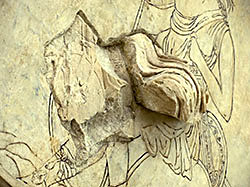
Incisions in the mortar for the reconstruction drawing are most visible from an angle. photo July 2008
|

The god of Virtue, Virtus, temporarily projected onto the flat background; slight overlap with pilaster. photo May 2010 |

The projected color coincides with remarkable precision with the lines incised in the flat mortar surface. photo May 2010 |

The god of Honor, Honos, temporarily projected onto the flat background. photo May 2010
|